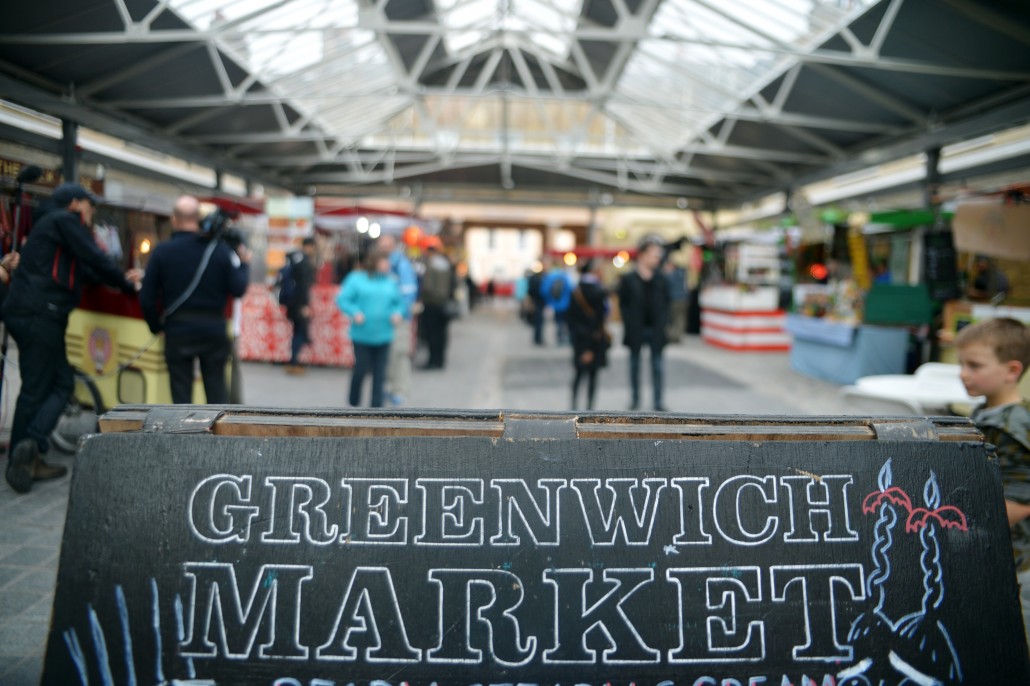Thanks to the Evening Standard for this nice little Greenwich Market Cookbook video:
You can buy it right here, priced £15.99 + free p&p in the UK.
Thanks to the Evening Standard for this nice little Greenwich Market Cookbook video:
You can buy it right here, priced £15.99 + free p&p in the UK.
It being pancake day and all, let us introduce you to the glory that is Vietnamese Pancakes. Tran from the Bánh Mì NêN stall at Greenwich Market gave us this recipe for The Greenwich Market Cookbook, and it is not only absolutely delicious but also happens to be gluten-free.
It is a great starter or light lunch – a thin, crispy coconut pancake stuffed with chicken, prawns and beansprouts and served with fresh coriander, mint and a salty-sour dipping sauce. It’s a very straightforward batter but you really do need a non-stick frying pan to cook it. The key is to let the pan get really hot, then turn the heat down to low when you start frying the pancake.
Ingredients
for the batter:
for the dipping sauce:
for the stuffing:
First make the batter. Mix the rice flour, coconut milk, turmeric and salt together in a big bowl and leave to rest in the fridge for 30 minutes. If it looks too thick, add another 30ml coconut milk or water so you have the consistency of double cream.
Make the dipping sauce: add the sugar, fish sauce, lime juice, garlic and chillies to 250ml water and stir until the sugar has dissolved. Put the chicken in one bowl and the prawns in another and season both with salt and pepper.
When you’re ready to eat, put a teaspoon of olive oil in small non-stick frying pan on a medium-high heat. Once it’s good and hot, add about a quarter of the onion and fry for a minute. Next, add a quarter of the chicken and prawns and fry briefly until the chicken is pale and the prawns have turned pink. Turn the heat down to low. Ladle over enough batter to thinly cover the base of the pan – tip the pan around so it spreads evenly and is as thin as possible. Scatter a handful each of beansprouts, mushrooms and spring onions over one half of the pancake, then cover and leave to cook for 3 minutes. When the batter is cooked through and crispy on the bottom and edges, fold over the side with no filling on it to form a half moon. Cut into four pieces and serve hot on a bed of iceberg lettuce, coriander and mint with the dipping sauce on the side. Repeat with the remaining ingredients to make three more pancakes. Each diner can then roll up bits of pancake with the cool crisp shreds of lettuce and herbs inside, and dip it into the sauce before eating.
Serves 4
Buy The Greenwich Market Cookbook here.
Bowl illustration by Kath Van Uytrecht
 We’ve been, happily, spending a lot of time at Greenwich Market over the last 18 months, working on The Greenwich Market Cookbook. For a market with such a huge footfall (around 8 million people last year), Greenwich still feels like a bit of a hidden gem. Since the 1830s, the market has been located in ‘the island’ – a purpose-built, covered area surrounded by wide streets and fringed with shops. When you first walk through the arch to the cobbled space inside, you’re immediately in another world. What makes it so special? Each day sees a changing roster of independent traders selling everything from jewellery to jam, military memorabilia to comics – and it’s a bargain, too. It has an authentically bohemian and friendly feel: some of the traders have been there for years, but there are also plenty who have given up day jobs to start up market businesses and they bring with them a freshness and enthusiasm that keeps the place brimming over with energy and ideas. Julia Johnson has been part of the market for forty years, ever since her parents established Pickwick Papers and Fabrics, their shop on the southern edge of the market which she now runs. “We are all creative here,” she says. Relations between the traders are friendly and supportive, and Julia still exchanges her own hens eggs for goods from other businesses. “You can’t come here and be superior,” she says. “You won’t fit in and you won’t last – this is a place for quirky, welcoming people.” She adds: “Apart from fabrics and colour, my other passion is food – I love being able to pop out and get freshly made sushi, or a beautiful box of halloumi and salad. I use the food market far, far too much!” Ah yes, the food…
We’ve been, happily, spending a lot of time at Greenwich Market over the last 18 months, working on The Greenwich Market Cookbook. For a market with such a huge footfall (around 8 million people last year), Greenwich still feels like a bit of a hidden gem. Since the 1830s, the market has been located in ‘the island’ – a purpose-built, covered area surrounded by wide streets and fringed with shops. When you first walk through the arch to the cobbled space inside, you’re immediately in another world. What makes it so special? Each day sees a changing roster of independent traders selling everything from jewellery to jam, military memorabilia to comics – and it’s a bargain, too. It has an authentically bohemian and friendly feel: some of the traders have been there for years, but there are also plenty who have given up day jobs to start up market businesses and they bring with them a freshness and enthusiasm that keeps the place brimming over with energy and ideas. Julia Johnson has been part of the market for forty years, ever since her parents established Pickwick Papers and Fabrics, their shop on the southern edge of the market which she now runs. “We are all creative here,” she says. Relations between the traders are friendly and supportive, and Julia still exchanges her own hens eggs for goods from other businesses. “You can’t come here and be superior,” she says. “You won’t fit in and you won’t last – this is a place for quirky, welcoming people.” She adds: “Apart from fabrics and colour, my other passion is food – I love being able to pop out and get freshly made sushi, or a beautiful box of halloumi and salad. I use the food market far, far too much!” Ah yes, the food…
Half of the market is given over to street food traders, selling food from all over the globe. The smells! The sights! The foods you’ve never even heard of and really had better try out! There is Madagascan coconut chicken. There is Ethiopian injera. There are wonderful, silky but robust La-mian (noodles) in amber broth. There are cakes galore: vegan cakes, gluten-free cakes, sugar-free cakes, full fat and full dairy cakes. It’s been a real pleasure to work with the traders on the book – and a real learning experience too. It’s such a global community that the recipes cover food from all over the world – from ramen burgers to ravioli, bánh mì to burritos. Now I know what they do with pounded cassava leaf in Madagascar – and very soon, so will you.
The market is owned and run by Greenwich Hospital, an ancient Crown charity providing charitable support including annuities, sheltered housing and education to serving and retired personnel of the Royal Navy and Royal Marines and their dependents. Greenwich Hospital have great vision for the market, and 2015 saw a raft of major improvements being implemented – a new glass roof, relaid cobblestones and a brand new pavilion that will host the all the street food traders. The market has remained open throughout, but traders and punters alike will be delighted when the works are completely finished in March this year.
Next time you have a spare day in London, I can wholeheartedly recommend getting the river boat up the Thames and having a wander around the parks of Greenwich, leaving plenty of time for a market lunch.
The Greenwich Market Cookbook comes out in March 2016. Pre-order here!
It’s been incredibly exciting seeing the recipes coming in from traders for the Greenwich Market Cookbook, everything from Arapina‘s wonderful Greek biscuits and pastries, delicate & fragrant & redolent with her family’s history in Asia Minor, to Pig Dogs & Brisket’s deep and dirty southern-style mac & cheese. But as well as being an inspiration, the global nature of the market has also brought along some difficulties.The La-Mian and Dim Sum stall is a quiet legend in street food circles – they used to work from Brick Lane but are now permanent fixtures in Greenwich – and from the moment the project started, I knew we had to get them on board. Lui Zhongyi and his wife Kelly make a wonderful array of food, but they are most famous for the hand-pulled noodles which Zhongyi pulls and stretches with a theatrical zeal quite at odds with his serious persona. Of course, he’s not really dour at all – he just isn’t so comfortable with the English language and as it was his culinary secrets we were after for the book, this was a problem. Enter the amazing Jessie Levene! Jessie is a polyglot, and a greedy one at that (I mean that as a compliment). Having spent 3 years in China, writing a column on regional foods and blogging about her experiences, she not only speaks great Mandarin but also has a real wealth of knowledge about the context of different Chinese dishes. So, thanks to Jessie we will have some of Zhongyi & Kelly’s domestic recipes in the book, but in the meantime she has also very generously given us some background about la-mian in general and some of her wonderful photos of noodle pullers in action in China. Here they is, because the second best thing to eating la-mian is reading about them:
La-mian (literally translated into English as ‘Pulled Noodles’) are a truly visual eating experience – fresh wheat dough pulled by hand into long, even strands, served in a plain beef broth. Perhaps this doesn’t sound all that special, but it must be seen to be believed, and in China, La-mian are usually made within eyesight of the diners. Through a magical and mind-boggling process of twisting, folding, pulling and loud slapping of the dough onto the work-board, the chef creates perfect noodles from raw dough in mere minutes. He or she also makes it look ridiculously easy, which it certainly is not.
La-mian comes from the city of Lanzhou, the capital of Gansu Province, in China’s north west region. Lanzhou is on the borderlands of Han China, meaning that it’s population is a lot more ethnically diverse than in the major cities on the east coast. One of the largest ethnic groups here is the Hui Muslim minority, and it is most often Hui chefs who one can find making La-mian across China. La-mian restaurants in China are usually pretty basic affairs, but are often open later than many other eating places, making them particularly convenient for a midnight snack. They’re also amongst the few restaurants in China where pork is not on the menu – Hui Muslims keep halal, and choice of meat at La-mian joints is usually only beef, chicken or lamb.
La-mian itself is a cheap, filling and delicious meal. The finished dish itself isn’t that much of a looker – just plain white noodles in a clear soup, topped with sliced cooked beef and fresh coriander. But it’s the visual spectacle of the making of the noodles, right in front of you, which makes La-mian so special.
Check out Jessie’s blog recounting her adventures around the world at http://jessielevene.com/.
